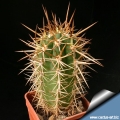




Your support is critical to our success.
in Rev. Hort. (1864) 173; Illustr. Hortic. 11., Misc. 15. 1864.
Family: CACTACEAE
Accepted Scientific Name: Echinopsis chiloensis (Colla) H.Friedrich & G.D.Rowley
I.O.S. Bull. 3(3): 94 (1974)
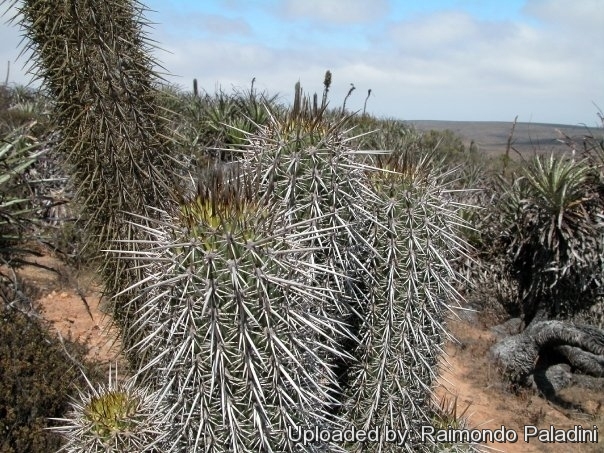
Spination at Elqui Valley, Coquimbo Region IV, Chile.
Origin and Habitat: Echinopsis chiloensisSN|7742]]SN|7742]] occur along the coast and in the coastal cordillera of Chile (North-Central Valley of Chile) in the regions of Maule, O'Higgins, Metropolitana, Valparaíso and Coquimbo, from Talca to Valle del Elqui.
Altitude: 0-2000 metres above sea level.
Habitat: Chilean matorral (sclerophyllous forest) in the upper north-facing hill-slopes that flank the higher Andes. The climate in this area is similar to that of the Southern Californian chaparral. Echinopsis chiloensisSN|7742]]SN|7742]] has a wide range, is abundant, and even though it has threats these occur only in portions of its distribution. The major threats are land use change due to agriculture of fruit trees and urbanization.
Synonyms:
- Echinopsis chiloensis (Colla) H.Friedrich & G.D.Rowley
- Cactus chiloensis Colla
- Cereus chiloensis (Colla) DC.
- Cereus coquimbanus DC.
- Cereus quintero Pfeiff.
- Echinocereus chiloensis (Colla) Console & Lem.
- Trichocereus chiloensis (Colla) Britton & Rose
- Trichocereus chiloensis var. polygonus (Salm-Dyck) Borg
- Trichocereus lucernatus hort.
Echinopsis chiloensis (Colla) H.Friedrich & G.D.Rowley
I.O.S. Bull. 3(3): 94 (1974)
Synonymy: 56
- Echinopsis chiloensis (Colla) H.Friedrich & G.D.Rowley
- Cactus chiloensis Colla
- Cereus chiloensis (Colla) DC.
- Cereus coquimbanus DC.
- Cereus quintero Pfeiff.
- Echinocereus chiloensis (Colla) Console & Lem.
- Trichocereus chiloensis (Colla) Britton & Rose
- Trichocereus chiloensis var. polygonus (Salm-Dyck) Borg
- Trichocereus lucernatus hort.
- Echinopsis chiloensis var. australis (F.Ritter)
- Echinopsis chiloensis var. borealis (F.Ritter)
- Trichocereus chilensis var. borealis F.Ritter
- Echinopsis chiloensis var. brevispinula (Salm-Dyck)
- Cereus chiloensis var. brevispinulus Salm-Dyck
- Echinopsis chiloensis var. conjungens (F.Ritter)
- Echinopsis chiloensis var. eburnea (Phil. ex K.Schum.) H.Friedrich & G.D.Rowley
- Cereus chilensis f. eburneus (Phil. ex K.Schum.) Schelle
- Cereus chiloensis var. eburneus (Phil. ex K.Schum.) K.Schum.
- Eulychnia eburnea Phil. ex K.Schum.
- Trichocereus chiloensis var. eburneus (Phil. ex K.Schum.) Borg
- Echinopsis chiloensis var. flavescens (Salm-Dyck)
- Cereus chiloensis var. flavescens Salm-Dyck
- Echinopsis chiloensis var. fulvibarbis (Otto)
- Cereus chiloensis var. fulvibarbis (Otto) Salm-Dyck
- Cereus fulvibarbis Otto & A.Dietr.
- Echinopsis chiloensis var. funkiana (J.Rémy)
- Cereus chiloensis var. funkianus Borg ex K.Schum.
- Cereus funkii K.Schum.
- Trichocereus chiloensis var. funkii (K.Schum.) Borg
- Trichocereus funkii (K.Schum.) A.Berger
- Echinopsis chiloensis var. heteromorphus (K.Schum.)
- Cereus chiloensis var. heteromorphus K.Schum.
- Echinopsis chiloensis var. panhoplites (K.Schum.)
- Cereus chiloensis var. panhoplites K.Schum.
- Cereus panoplaeatus Cels ex Salm-Dyck
- Trichocereus chiloensis var. panhoplites (K.Schum.) Borg
- Echinopsis chiloensis var. polygona (Salm-Dyck)
- Cereus chiloensis var. polygonus (Salm-Dyck) K.Schum.
- Echinopsis chiloensis var. poselgeri (K.Schum.)
- Cereus chiloensis var. poselgeri K.Schum.
- Echinopsis chiloensis var. pycnacantha (Salm-Dyck)
- Cereus chiloensis var. pycnacanthus (Salm-Dyck) K.Schum.
- Cereus pycnacanthus Salm-Dyck
- Trichocereus chiloensis var. pycnacanthus (Salm-Dyck) Borg
- Echinopsis chiloensis var. quisco (J.Rémy)
- Cereus chilensis var. quisco (J.Rémy in Gay) F.A.C.Weber ex Hirscht
- Cereus chiloensis var. quisco (J.Rémy) F.A.C.Weber ex Hirscht
- Cereus quisco Remy in Gay
- Trichocereus chiloensis var. quisco (J.Rémy) Borg ex Hirscht
- Echinopsis chiloensis var. zizkaana (K.Schum.)
- Cereus chilensis var. zizkaanus K.Schum.
- Cereus chiloensis var. zizkaanus K.Schum.
- Cereus zizkaanus hort. ex Schelle
- Trichocereus chiloensis var. zizkaanus (K.Schum.) Borg
Echinopsis chiloensis subs. litoralis (Johow) M.Lowry
Cactaceae Syst. Init. 16: 8 2003.
Synonymy: 5
- Echinopsis chiloensis subs. litoralis (Johow) M.Lowry
- Cereus litoralis Johow
- Echinopsis litoralis (Johow) H.Friedrich & G.D.Rowley
- Trichocereus chiloensis subs. litoralis (Johow) Faúndez
- Trichocereus litoralis (Johow) Looser
Echinopsis chiloensis subs. skottsbergii (Backeb. ex Skottsb.) G.J.Charles
Cactaceae Syst. Init. 19: 13 2005. [Mar 2005]
Synonymy: 5
- Echinopsis chiloensis subs. skottsbergii (Backeb. ex Skottsb.) G.J.Charles
- Echinopsis skottsbergii (Backeb.) H.Friedrich & G.D.Rowley
- Trichocereus skottsbergii Backeb. ex Skottsb.
- Echinopsis skottsbergii var. breviata (Backeb.) H.Friedrich & G.D.Rowley
QUECHUA (Runasimi / Qhichwa simi): Khishka
RUSSIAN (Русский): Эxинопсис чилийский
SPANISH (Español): Cacto, Quisco
Description: Echinopsis chiloensisSN|7742]]SN|7742]] previously known as Trichocereus chiloensisSN|7744]]SN|7744]] is a fiercely spiny cactus.
Growth Habits: Rarely single, it usually develops into a multi-stemmed shrub or small tree, with branches
arising from near the base, starting nearly at right angles to the main trunk but soon erect, the tallest sometimes 8 meters high.
Stem: Up to 8 m tall, stems 10-12 cm in diameter.
Ribs: 10 to 17 low and broad, separated by narrow intervals, divided into large tubercles even when fully mature.
Areoles: Large whitish, 2 cm apart.
Spines: Yellowish with brown tips, at least when young, greyish later.
Central spines: 1 to 4, porrect, projecting, often stout, usually 5-7 cm long, but some of the longest spines can grow up to 25 centimetres long .
Radial spines: 8 to 12 radials, 1-4 cm long, lightly spreading, often stout.
Flowers: Nocturnal 14 cm. long, outer perianth-segments white but tinged with red or brown; inner perianth-segments white, acuminate. Style green below, cream-coloured above; stigma-lobes about 18 cream-coloured up to 15 mm long.
Fruit: Globular.
Subspecies, varieties, forms and cultivars of plants belonging to the Echinopsis chiloensis group
 Echinopsis chiloensis (Colla) H.Friedrich & G.D.Rowley: It is a fiercely spiny cactus. Like it's relatives, this species is a quick grower and is reported to grow into a shrub or small tree up to 8 m in height. Distribution: coastal cordillera of Chile (North-Central Valley of Chile)
Echinopsis chiloensis (Colla) H.Friedrich & G.D.Rowley: It is a fiercely spiny cactus. Like it's relatives, this species is a quick grower and is reported to grow into a shrub or small tree up to 8 m in height. Distribution: coastal cordillera of Chile (North-Central Valley of Chile) Echinopsis chiloensis var. borealis (F.Ritter): can produce very long spines, up to 25 cm long. Distribution: Elqui valley, Huanta, Coquimbo, Chile
Echinopsis chiloensis var. borealis (F.Ritter): can produce very long spines, up to 25 cm long. Distribution: Elqui valley, Huanta, Coquimbo, Chile Echinopsis chiloensis var. eburnea (Phil. ex K.Schum.) H.Friedrich & G.D.Rowley: This is the stouter spined form with impressive and showy ivory spines and all spines long; flowers pinkish. Distribution: East of Los Patos, bottom of valley, Coquimbo, Chile.
Echinopsis chiloensis var. eburnea (Phil. ex K.Schum.) H.Friedrich & G.D.Rowley: This is the stouter spined form with impressive and showy ivory spines and all spines long; flowers pinkish. Distribution: East of Los Patos, bottom of valley, Coquimbo, Chile. Echinopsis chiloensis subs. litoralis (Johow) M.Lowry: is shrubby with arching or erect cylindrical branches less than 2 m tall. Its has much shorter, thinner and flexible spines. Distribution: coast north of Valparaiso (Atacama, Coquimbo).
Echinopsis chiloensis subs. litoralis (Johow) M.Lowry: is shrubby with arching or erect cylindrical branches less than 2 m tall. Its has much shorter, thinner and flexible spines. Distribution: coast north of Valparaiso (Atacama, Coquimbo). Echinopsis chiloensis var. panhoplites (K.Schum.): Young spines almost black, central spine very long. Distibution: Ovalle, Coquimbo, Chile.
Echinopsis chiloensis var. panhoplites (K.Schum.): Young spines almost black, central spine very long. Distibution: Ovalle, Coquimbo, Chile.- Echinopsis chiloensis var. pycnacantha (Salm-Dyck): spines very short and thick.
- Echinopsis chiloensis subs. skottsbergii (Backeb. ex Skottsb.) G.J.Charles
Notes: The original name for this cactus was Trichocereus chiloensisSN|8255]]SN|7744]]. In 1950, Skottsberg pointed that the name was misspelled, and was changed to "chilensis" for "Chile"+"ensis". The rules of nomenclature now, give priority to the original name, misspelling included, except if the name was changed by the original author. Thus, Friedrich & Rowley retained chiloensis when they included the genus Trichocereus into the genus Echinopsis.
This species is occasionally confused with Trichocereus litoralisSN|7744]]SN|8255]].
Bibliography: Major references and further lectures
1) Edward Anderson “The Cactus family” Timber Press, Incorporated, 2001
2) James Cullen, Sabina G. Knees, H. Suzanne Cubey "The European Garden Flora Flowering Plants: A Manual for the Identification of Plants Cultivated in Europe, Both Out-of-Doors and Under Glass" Cambridge University Press, 11/Aug/2011
3) David R Hunt; Nigel P Taylor; Graham Charles; International Cactaceae Systematics Group. "The New Cactus Lexicon" dh books, 2006
4) Friedrich Ritter "Kakteen in Südamerika: Ergebnisse meiner 20jährigen" Volume 2, Argentinien/Bolivien, Volume 2 Selbstverlag, 1980
5) Curt Backeberg “Die Cactaceae: Handbuch der Kakteenkunde,” Volume 2 G. Fischer, 1959
6) N. L. Britton and J. N. Rose “The 'Cactaceae', Descriptions and Illustrations of Plants of the 'Cactus' Family” volume 2 Carnegie Institution, 1920
7) Riedemann, P. y G. Aldunate. “Flora Nativa de Valor Ornamental; Identificación y Propagación. Chile, Zona Centro." Edición 2, Chile 2004.
8) Gordon Douglas Rowley "Reunion of the genus Echinopsis”. In: IOS Bulletin. Journal of the International Organization for Succulent Plant Study. Volume 3, Nuber 3, page 94 , 1974
9) Haustein, Erik. “Der Kosmos-Kakteenführer.” Kosmos / Gesellschaft der Naturfreunde., Stuttgart, 1983
10) Walter, H.E., Faundez, L., Guerrero, P. & Saldivia, P. 2013. Echinopsis chiloensis. In: IUCN 2013. "IUCN Red List of Threatened Species". Version 2013.1. <www.iucnredlist.org>. Downloaded on 31 October 2013.
11) David Yetman “The Great Cacti: Ethnobotany & Biogeography” University of Arizona Press, 2007
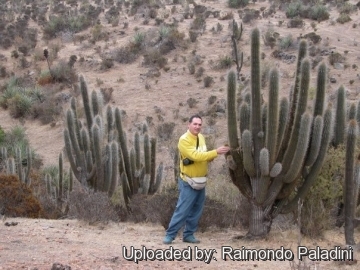
Echinocereus chiloensis (Echinopsis chiloensis) Photo by: Raimondo Paladini
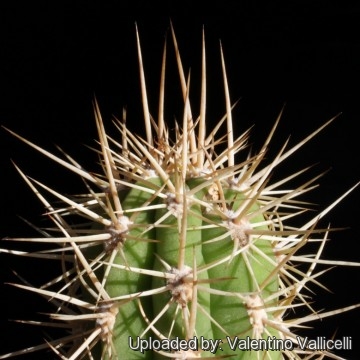
Echinocereus chiloensis (Echinopsis chiloensis) Photo by: Valentino Vallicelli
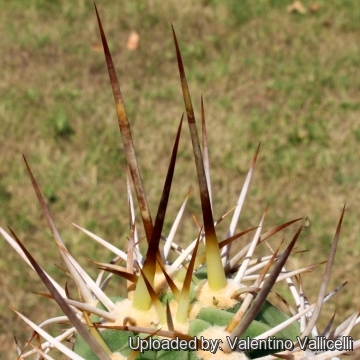
Echinocereus chiloensis (Echinopsis chiloensis) Photo by: Valentino Vallicelli
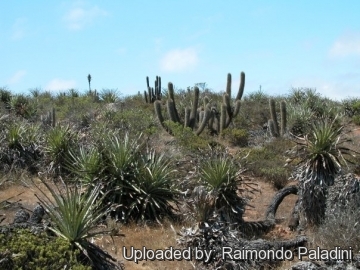
Elqui Valley, Coquimbo Region IV, Chile (Echinopsis chiloensis) Photo by: Raimondo Paladini
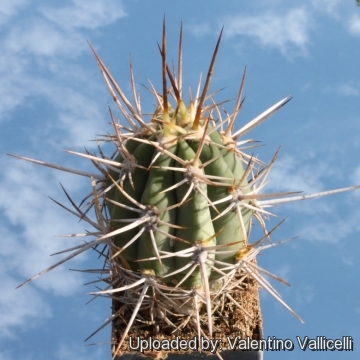
Echinocereus chiloensis (Echinopsis chiloensis) Photo by: Valentino Vallicelli
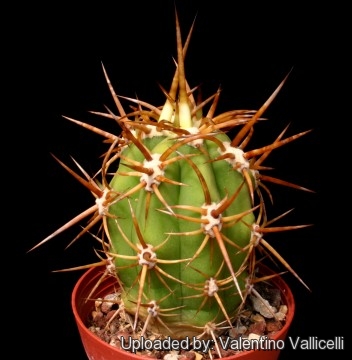
Echinocereus chiloensis (Echinopsis chiloensis) Photo by: Valentino Vallicelli
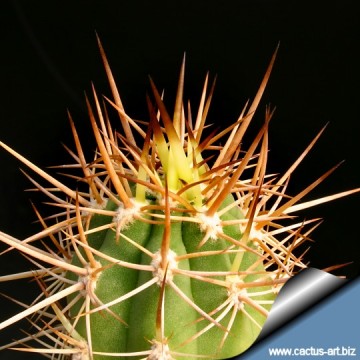
Echinocereus chiloensis (Echinopsis chiloensis) Photo by: Cactus Art
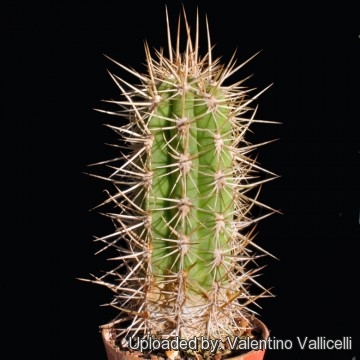
- Like it's relatives, this species is a quick grower and is reported to grow up to 8 m in height. (Echinopsis chiloensis) Photo by: Valentino Vallicelli
Cultivation and Propagation: Echinopsis chiloensisSN|7374]]SN|7742]] is very easy to grow and cold hardy as low as -12°C (or less). Need a fertile, well drained soil mix. Water the plants well and allow them to dry before watering again. This species seems to do better with a little more water than most cacti. In fact, its cultivation requirements are really more like 'normal' plants than most other cacti. During the growing season fertilize them monthly with a balanced fertilizer
Sun Exposure: Outside full sun, inside needs bright light, and some direct sun. During winter month, put them in a cool luminous place and encourage them to enter winter dormancy by withholding water and fertiliser over the winter as they will etiolate, or become thin, due to lower levels of light.
Pest smd diseases: They are susceptible to fungal diseases if overwatered, but are not nearly as sensitive as many other cacti, especially in warm weather. They tend characteristically towards black rotted spots unless watering is moderate and only in hot weather, if kept damp through cold periods, they will invariably suffer.
Growth rate Echinopsis chiloensisSN|7742]]SN|7742]] produces noticeable amounts of growth each year if kept well fed and watered throughout the warmest months, particularly if it has been acclimatised to accept full sun. Once this cactus is established it can easily produce 20 cm of growth every year.
Traditional uses: A popular item sold in many regions of the world is the rain stick of Chile, made from the dried skeleton of the stem of Echinopsis chiloensisSN|7742]]SN|7742]] or Eulychnia acidaSN|7067]]SN|7067]]. The dry stems are harvested in the field, cleaned, and prepared by pushing stout spines through the areolar gaps in the wood. The cylinders of the wood are sealed and filled with various materials, such as volcanic sand or pebbles, that run up and down when the stick is tilted. These are then sold locally and overseas. The trade in rainsticks made from cacti has increased in recent years, giving rise to concern over the impact on the wild populations. Rain sticks are also made from the wood of the cardon, Echinopsis atacamensisSN|7742]]SN|7374]] subsp. pasacana, in northwestern Argentina.
Propagation: Cutting or from seed. The seeds are quite easy to germinate and grow. Their main requirements consist of high humidity levels, free-draining soil mix, and enough water, light, and nutrition.
| Your Actions | |
|---|---|
| Back to Echinocereus index | |
| Back to Cactaceae index | |
 |
Back to Cacti Encyclopedia index |
Privacy stantement - Terms and conditions - How to cite - About us - Feedback - Donate





